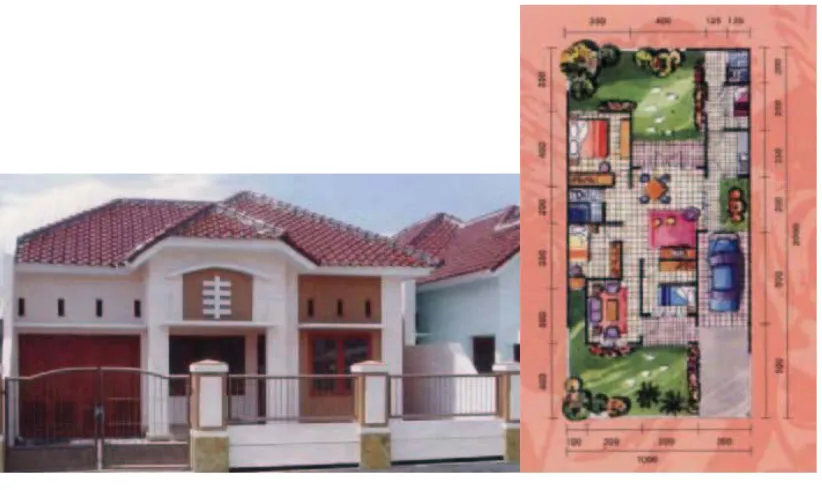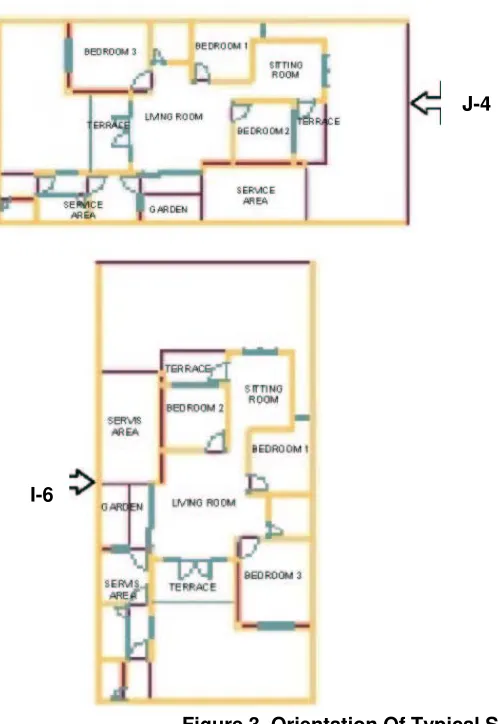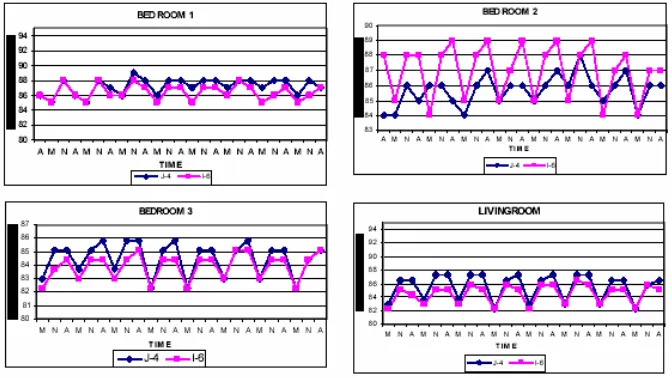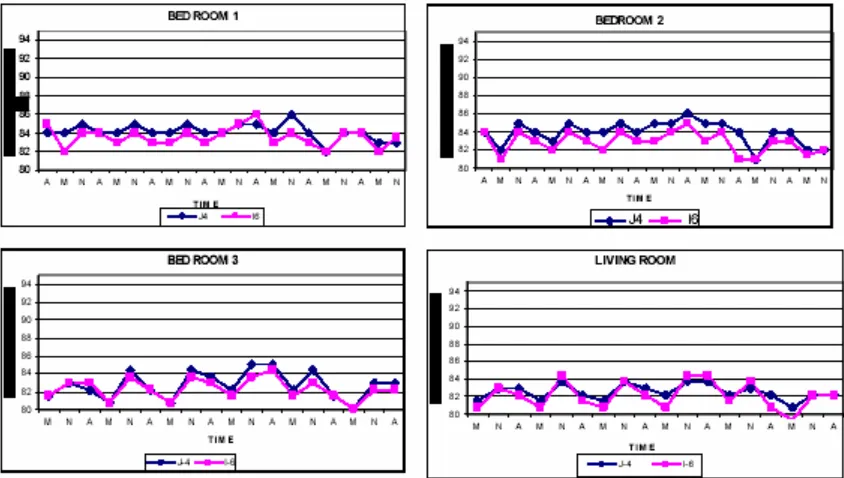Effect Of Orientation On Indoor Temperature
Case Study: Yekape Penjaringansari Housing in
Surabaya
Wanda W. Canadarma
- E-mail : [email protected]Anik Juniwati
– E-mail : [email protected]Luciana Kristanto
- E-mail : [email protected] Members of Tropical Architecture Research Group.Department of Architecture, Petra Christian University, Surabaya Jl. Siwalankerto 121-131, Surabaya 60236, Indonesia
Keywords : house, building orientation, indoor temperature.
Abstract : Building orientation has an important impact to the indoor building temperature. Theoretically, different building orientation would received different heat gain thus different indoor temperature accordingly.
Housing developer usually built a typical house-design without building orientation heat gain difference as concern.This paper aimed to explore the impact of building orientation toward the indoor temperature of typical house-design, which built on two different site orientations. The time measurement based on extreme sun-paths of Surabaya in wet and dry seasons to describe thoroughly the outdoor temperature and the house’s indoor temperature of both orientations. By comparing the rooms indoor temperature of each house, the indoor temperature profile wiil be gained.
1. Introduction.
Recently, the housing needs in Surabaya as a big city increase as much as the increasing of human population. This condition pushes the housing developers to built the housing project with some typical of house-designs. The developers use these typical designs on economical reason, in order to build easier, faster and therefore getting more benefit to them. A typical house-design usually build on any charateristic sites, with ignorance of environmental and climatic aspects of building site: as example, without a concern to the impact of building orientation to sun.
Surabaya is in warm-humid climate, the air temperature almost hot and stable conditions predominate with high relative humidity throughout the year, dominant with solar radiation. This climate characther brings many impact to the indoor thermal comfort. From six major factors that determine thermal comfort, the temperature of the air around human body is the most important of all those factors (Agarwal, 1998). The solar radiation and the ambient air condition affect the outdoor temperature would influence the indoor temperature.
By describing some fundamental results about the differences of the building orientation, indoor temperature in typical house-design, the effect off building orientation on the indoor temperature will be described.
2. House.
In most fundamental form, housing is shelter - a system of components designed to mediate the existing environment into a comfortable and satisfactory environment. Historically, shelter has been built to reduce the range of local climatic variations, to avoid some of the heat of the sun in hot climates, to welcome the breezes when they can provide, to admit light in sufficient amounts for task lighting. (Moore, 1993)
month of each season. These long-term evereges are important to determinate the comperative importance that should be given to various building design strategies. (Moore, 1993)
2. Building Orientation.
The orientation of a building is affected by the quantities of solar radiation falling on different sides at different times. It has been recognized that both radiation and temperature act together to produce the heat experienced by a body or surface. (Konya, 1980)
In his book Design With Climate, Olgyay ( ) describes a sol-air approach to orientation in which not only the radiation receipts are considered, but also the heat impact of the diurnal temperatures. In hot climate areas protection from solar radiation is particularly important during times of
excessive heat when there can be a difference of as much as 3 °C in air temperature in a building between the worst and best orientation.
Housing developers in Surabaya, the houses mostly toward north, south and east, as better orientation than directing the houses to west, as the worst orientation to the sun radiation.
3. Air Temperature.
Temperature is the measure of the average vibrating energy in each of the molecules of a substance. Temperature, then, is a measure of the concentration of heat within a substance. It is frequently assumed that a high temperature means that a substance contains more heat. (Moore,1993). In this case, air temperature, it means the heat substance in the air, influenced by three types of heat transfer : conduction, radiation and convection. Temperature familiar measures in degrees Fahrenheit or Celcius.
The combined thermal effect of solar radiation is expressed in the sol-air temperature. The sol-air temperatur include three component temparature: the first is the outdoot component, the second represent the solar radiation absorbed by the surface on which it is incident. The third represents the long-wave radiant heat exchange with the environment. ( Givoni, 1976)
To give thermal difinition, the sol-air for this surface of given stuctural element in theoretical
external air temperature which, in the absence of radiant heat exchange, would produce the same thermal effect on the element as the existing combination of insident radiation and ambient air conditions. That is it would produce the same external surface temparature, heat flow into and across the element and internal temperature. ( Givoni, 1976).
In warm to hot climates, most human daily activity tends to take place in relatively cool mornings, and everyone slows down in the hot afternoon. This ensures that people’s metabolism and heat generation is minimized during the hottest part of the day. In this warm-humid climate, the indoor air temperature should be more comfortable than the outdoor air temperature to ensure thermal comfort to the occupants activity, because the deep body temperature must be maintained constant.
4. Discussion
This study carried out at YKP – KMS Housing, Surabaya which has built houses at several housing areas in Surabaya, since 1954 until now, incorporated with Kota Madhya Surabaya as local government, that are :
a. 1954 - 1965 : Dharma Rakyat (Central East Surabaya), Wonosari Kidul, Jalan Tales, Kemayoran Baru, Pucang and Ngagel
b. 1965 - 1979 : Mojoarum, Jemur Andayani, Kendangsari, Gayungan, Tenggilis, Rungkut Kidul and Rungkut Lor.
c. 1979 – now : Medokan Ayu, Pandugo, Wonorejo (South East Surabaya), Penjaringansari This YKP – KMS Housing developer consistently built a conservative housing design that fulfill healthy standard house as the decision of Kongres Perumahan Rakyat. This healthy standard house-design typology should consist of at least 2 bedrooms, guest room, living room, kitchen, and bath room and service area. This YKP – KMS houses, mostly occupied by middle professionals.
(YKP - KMS, 2006). From all YKP - KMS housing area, the latest was Penjaringansari Housing and relatively unoccupied.
unbuilt site, and the activity rooms such as bedrooms and livingroom are next to the adjacenthouses.
Figure 1. Site Plan (YKP-KMS)
Elevation Plan
Figure 2. Zamrud-type House (YKP-KMS)
In each typical house, the indoor temperature measured in the three bedrooms and in the livingroom to get the dry-bulb temperature, using manual conventional thermometer, digital
J-4
I-6
Figure 3. Orientation Of Typical Study House
On August, the sun path was still in north, the indoor temperature in Bedroom 1 resulted as shownin figure 4 on left-above graph, at J-4 house (faced to east), was relatively hotter (0,9 deg F in themorning till noon and 0,8 deg F at the afternoon) than I-6 (faced to north). J-4 was hotter becausethe window is oriented to the east, it mean the sun radiation directly entered the room sincemorning till noon. Whilst at I-6, the window of Bedroom 1 was in between the other rooms wall,there was no direct sun radition entered the room.
In Bedroom 2, in figure 4 on right-above graph the I-6 (faced to north) indoor temperature was hotter 1 deg F from noon till afternoon than the J-4 (faced to east), because at I-6 the bedroom window was oriented to north, it means the sun radiation entered through the window before noon until afternoon and heated the indoor temperature. Whilst in the morning J-4 is slightly hotter 0,3 deg F than I-6, because the direct sun rise radiation entered the room.
In Bedroom 3, in figure 4 on left-below graph, the J-4 (faced to east) indoor temperature was averagely hotter than I-6 (faced to north), 1.5 deg F in the morning, 1.9 deg F at noon, and at afternoon the indoor temperature was 1.4 deg F hotter. Because the I-6 Bedroom 3 window was oriented to south, therefore almost no direct sun radiation entering the room. Whilst in J-4, the window oriented to the west and shaded by the backyard wall. So, the sun radiation only entered the window in short time at noon.
north and shaded by the adjacent house. In I-6, one side window was oriented to south, while the other oriented to the west and shaded by the adjacent house.
October is the hottest season, and the sun path is right above Surabaya. The indoor temperature inBedroom 1 shown on left-above graph in figure 5; J-4 (faced to east) was hotter than I-6 (faced to north). The indoor temperature at J-4 is 2 untill 2,3 deg F higher than I-6 in whole day, because the window is oriented to the east and it influences the indoor temperature as on August. Whilst in I-6,the sun radiation entered the room undirectly.
In Bedroom 2, on right-above graph in figure 5 the indoor temperature at J-4 (face to east) in average was 2,1 deg F in the morning, 1 deg F at noon and 1,3 deg F at the afternoon hotter than at I-6 (face to north). J-4 wais hotter because the sun radiation directly entered to the room through the window which oriented to east from early morning till noon. At I-6 the direct sun radiation did not enter the window.
Figure 4 Comparison of The Temperature Fluctuation on August
Figure 5 on left-below graph shows the indoor temperature in Bedroom 3 in both houses were similar, because no direct sun ratiation entered to those room. The window at Bedroom 3 in J-4, oriented to the west, it shaded by the backyard wall, so there was no direct sun radiation entered to
the window. At I-6 the sun radiation did not enter directly to the window because it oriented to the south., but from morning till noon it was 1 deg F hotter.
Figure 5 Comparison of The Temperature Fluctuation on October
On December, in hot-rainy season and the sun path is in the south, the weather sometimes rainy, cloudy, and the sun radiation was diffused. In those weather the sun radiation intensity is relatively similar to all orientations.
The indoor temperature as shown right-above graph in figure 6, in Bedroom 1, at J-4 (faced to east)
was slightly hotter than at I-6 (faced to north). At J-4 in the morning the sun radiation entered the room directly through the east oriented window and heated the indoor temperature untill 1,2 deg F hotter. During the day, in J-4 the indoor temperature in average 0,3 deg F hotter. At I-6, the window faced to north, so there was no direct sun radiation entered the room.
In Bedroom 2 as shown in figure 6 on left-above graph, at J-4 (faced to east) relatively hotter 0,9 deg F in the morning, 0,7 deg F at noon, 1,3 deg F in the afternoon than at I-6 (faced to north), It was hotter because the window oriented to east. This condition made the indoor temperature in Bedroom 2 at J-4 hotter than at I-6.
The indoor temperature in Bedroom 3 at J-4 (faced to east), as shown in figure 6 on left-below graph, cooler than I-6 (faced to north). There was no direct sun radiation entered to the south oriented window at I-6 and the west oriented window at J-4, because when at the time the sun position in the west (afternoon) the weather tends to rainy, cloudy, and the sun radiation was diffused. This weather resulted to the indoor temperature relative cool maximum 82 deg F in the morning, 85 deg F at noon and on the afternoon.
Figure 6 Comparison of The Temperature Fluctuation on December
7. Conclusion
From this study, we found that a house oriented to North (I-6) is generally cooler than the East oriented (J-4). The bedrooms on east oriented house are hotter than the North oriented. In the middle of the livingroom on East oriented house, the indoor temperature is also hotter than the North oriented house. The different indoor temperature in each house orientation, could affect the indoor thermal comfort if it studied more detail. So, as conclusion the indoor temperature in each house depends on the building orientation to the sun position. By this study, we suggested not to apply typical house-design to every site orientation. A typical house-design only suitable to a certain orientation.To get a cooler indoor temperature, bedroom and livingroom areas should be located in the right zona according to the sun path. The facade in each house orientation should be
design fitted to it's orientation.
8. References
Agarwal, P., 1998, http://architecture.arizona.edu/Templates/bcdc/about/index.html, February, 6, 2006.
Givoni, B, 1976, Man, Climate and Architecture second edition, London: Applied Science Publishers Ltd.
Konya, A, 1980, Desin Primair For Hot Climate, London: Architectural Press Ltd.
Moore, Fuller, 1993. Environmental Control Systems, heating cooling lighting, New York: Mc Graw-Hill, Inc.
Olgyay, V, 1992, Design Primer With Climate, New York: Van Nostrand Reinhold.




